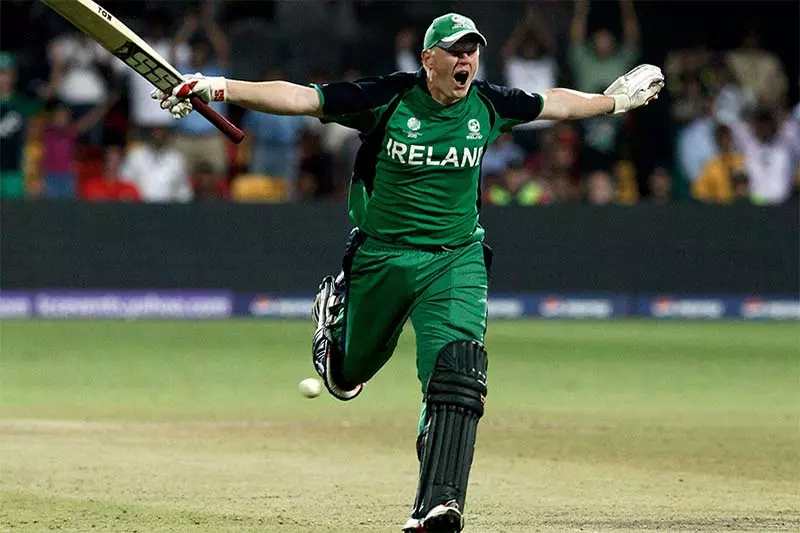What Afghanistan and Ireland could mean for Test cricket

ON Thursday, the cricket’s top flight grew by two as Afghanistan and Ireland were approved as Full Members of the International Cricket Council (ICC).
It is the first time any ICC Associate has been elevated since 2000, when Bangladesh became the 10th nation to earn Test status.
The announcement comes amid growing concerns about the long-term viability of the sport’s longest format, especially with the rise and rise of domestic Twenty20 cricket around the world.
But for the two nations that now have the chance to play at the highest level, it is an honour that could shape their respective futures.
“Test cricket is the pinnacle, it’s the best,” said Warren Deutrom, chief executive of Cricket Ireland.
For years, a lack of local career prospects has forced the best and brightest Irish talents to resettle in the UK.
Notable examples include Ed Joyce, Boyd Rankin and Eoin Morgan, the latter of whom now captains England in One Day Internationals.
“Not being able to play Tests was the reason cited by some players, who weren’t able to achieve that career fulfilment with Ireland, as the reason they went to England,” Deutrom continued.
“That reason is now removed, we can play Tests ourselves.
“Who can say for certain that players won’t leave in the future, but that can’t be the reason for it now.”
Despite losing many of their most gifted players, the Irish have competed well at the Cricket World Cup and claimed some big scalps since entering the ODI scene in 2005.
The rapid rise of Afghanistan has been even more impressive.
Less than a decade ago, the war-torn nation did not even hold Associate status with the ICC.
But cricket has flourished in the region since 2009 and now ranks as the country’s most popular sport.
With homegrown talents such as Mohammad Nabi and Rashid Khan earning big reputations on the world stage, it was only a matter of time until Afghani cricket reached the next level.
“Another day that we can lock in our history and be proud,” said Shafiq Stanikzai, chief executive of the Afghanistan Cricket Board.
“Every achievement is great, but it opens the door to challenges.
“We’ll be hosting our international matches in Greater Noida and Sharjah, there should be a day when we can host inside Afghanistan.”
What this means for the future of Test cricket
The decision to promote Afghanistan and Ireland suggests the ICC has not quite given up on Test cricket after all.
Both nations now run domestic first-class competitions, and this latest endorsement only increases the potential for player development, talent retention and greater professionalisation on the local front.
It also gives a few hints about the direction in which the five-day game might be heading.
With 12 nations now holding Full Member status, the world governing body may well be ready to revisit the idea of a multi-tier Test championship.
Among the biggest issues facing the long form of the game – and the diverse cricket betting scene that goes with it – is the the lack of serious competition between the top teams and the bottom few.
While things might be a little more even in the limited-overs formats, the likes of Australia, India and South Africa tend to bully the Bangladeshes and Zimbabwes on the Test stage.
But what if there were two separate divisions?
By splitting the top six and bottom six teams in the ICC Test rankings, we could have two well-balanced brackets with clear benchmarks and a long-term competitive element.
As things stand, it would shape up like so:
First division
- India
- South Africa
- Australia
- England
- New Zealand
- Pakistan
Second division
- Sri Lanka
- West Indies
- Bangladesh
- Zimbabwe
- Afghanistan
- Ireland
There are drawbacks to that scenario, the most obvious being that it would deprive the lower-ranked nations of the benefits that come with playing high-profile fixtures against the best in the world.
One could also argue that instead of bringing Afghanistan and Ireland into the realm of the elite, a split system would create a new subdivision while enthroning the powerhouse nations.
But the raw truth is this: Test cricket will not survive unless it is much better, much more often.
What we have now are glorified exhibition matches that hold little meaning on a broader scale.
Put Sri Lanka and the Windies in a battle for a place in the top tier, however, and things become instantly more entertaining for all concerned.
An official Test championship might also open up some interesting opportunities for the gambling industry.
Think about it: with something more akin to a league system in play, bookmakers could carve out dozens of new cricket betting markets with potential worldwide appeal.
Outright bets for each division, future options for top runscorers and wicket-takers, promotion and relegation betting – it could be a real money-spinner for bookies and punters alike.
More News
-

NFL Week 5 betting tips, predictions & multi picks
-

UCL soccer betting preview & best bets | October 2, 2025
-

New Zealand v Australia cricket tips & best odds | First T20
-

Champions League Matchday 2 tips & predictions | October 1
-

UFC Perth betting preview, tips & full card analysis | Sept 28
-

AFL Grand Final 2025 betting tips & odds | Geelong v Brisbane
-

NRL Finals Week 3 betting tips, multi picks & predictions
-

NFL Week 4 betting tips, predictions & multi picks






